

城市建成环境对共享单车出行影响的时空特征——以深圳市为例
|
项振海(1982—),男,湖北黄冈人,讲师,博士,主要从事城市地理与城市规划研究,(E-mail)xiangzhh3@qq.com; |
收稿日期: 2023-10-19
修回日期: 2023-11-10
网络出版日期: 2024-02-08
基金资助
国家自然科学基金项目(51878284)
云南省社科规划社会智库项目(SHZK2023336)
云南省科技厅基础研究专项—面上项目(202201AT070792)
Effects of Built Environment on the Spatio-Temporal Trajectories of Shared Bicycles: A Case Study of Shenzhen
Received date: 2023-10-19
Revised date: 2023-11-10
Online published: 2024-02-08
以深圳市为例,利用共享单车OD等多源数据,从工作日、休息日多时段分析共享单车出行时空特征,并构建基于客观物质空间、主观感知体验的建成环境“5Ds”指标,运用多尺度地理加权回归模型(MGWR)解析不同建成环境对共享单车出行流量影响的时空异质效应。研究表明:1)时间上,工作日和休息日早、晚高峰的共享单车出行流量较其他时段整体显著,且休息日较工作日的峰值时段具有滞后性;空间上,各峰值时段的出行流量高值区域呈“多核集聚、带状延伸”的分异格局;2)各建成环境要素对共享单车出行流量影响的时段差异显著。就业设施密度、围合度及人口密度在各时段均具有高解释度,其影响力整体呈全局显著特征,其余变量则在不同时段存在局部显著效应;3)各时段影响较为显著的变量在空间作用尺度上存在分异。就业设施密度与围合度的影响力在各时段的空间变化最为稳定,街道绿视率与人口密度在不同时段呈现差异化的空间分布特征。
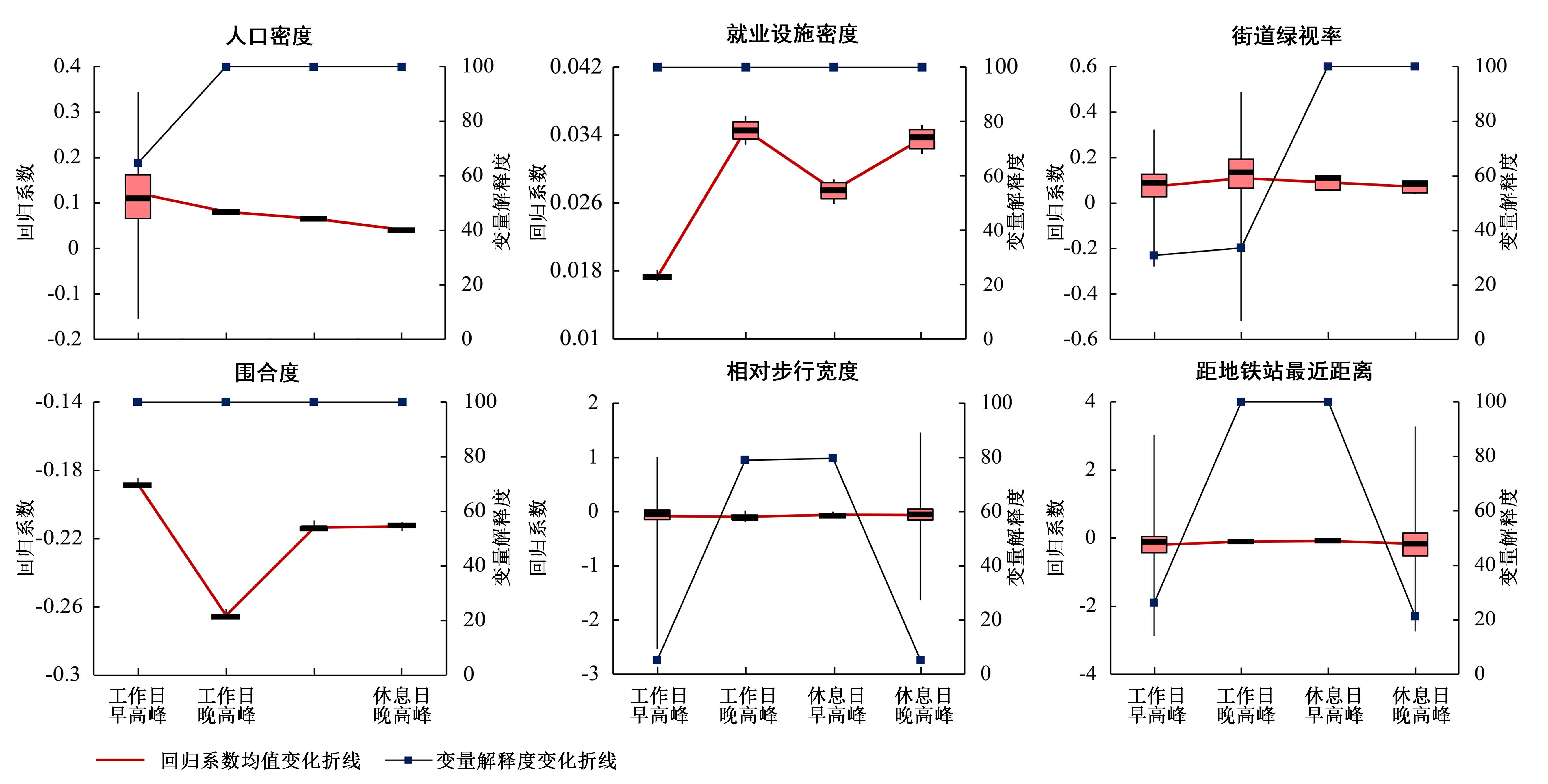
项振海 , 李青 , 洪良 , 盛杰 , 班鹏飞 . 城市建成环境对共享单车出行影响的时空特征——以深圳市为例[J]. 热带地理, 2024 , 44(2) : 236 -247 . DOI: 10.13284/j.cnki.rddl.003829
With the rapid development, shared bicycles have gradually become an important part of slow urban traffic in China and have played an important role in satisfying the travel needs and facilitating the transfer of residents. Exploring the spatial and temporal characteristics of the impact of the built environment on shared bike travel is of practical importance to reshape the construction of low-carbon transportation and an urban-friendly cycling environment dominated by slow traffic and public transportation. We analyzed the spatio-temporal characteristics of shared bicycle travel through multi-source big data including Shenzhen's shared bicycle OD data, OSM road network data, Baidu Street View, and POIs and used a multi-scale geographical weighted regression model (MGWR) based on the "5D" index of the built environment to analyze the spatial difference characteristics of the impact of different built environment on shared bicycle flow. The findings of the research indicate that: (1) In terms of time, the shared bicycle flow in the morning and evening peaks of both working and rest days is more significant than that of other periods, and the peak period of the remaining days lags behind that of the working days. (2) In terms of space, the spatial distribution characteristics of the traffic flow of shared bicycles during each peak period exhibit a spatial pattern of "multiple aggregation cores and several extended belts." (3) Significant differences were observed in the impact of various built environmental factors on the flow of shared bicycle travel, among which, employment facility density, enclosure degree and population density had a positive effect in each period; their influences were globally significant; and the remaining factors demonstrated varied characteristics in each period. (4) Factors with significant influence showed different spatial scales in different periods. The spatial changes of employment facility density and enclosure in each period were generally flat; the spatial changes of proximity, density of shopping facilities, and the nearest distance to subway stations in some periods were generally flat; the spatial changes of building continuity and relative walking width were obvious in some periods. Moreover, population density and green vision rate had different spatial characteristics in different periods. This study restores the travel track of shared bicycles, analyzes the spatiotemporal characteristics of shared bicycle travel in multiple periods of working days and rest days and long-term series, and increases micro-built environment factors of subjective perception of people and experience dimension based on existing objective material space environment variables, to explore the spatiotemporal differences of the impact of different built environments on the travel flow of shared bicycles which compensate for the existing shared-bike travel time and space characteristics, build a shortage of environmental impact research, and provide references for the construction of an urban-friendly cycling environment and the creation of a slow walking space.

表1 共享单车时空分布特征的影响因子Table 1 Factors influencing the spatio-temporal distribution characteristics of shared bicycles |
| 类别 | 因子 | 因子解释 | |
|---|---|---|---|
| 建 成 环 境 | 密度 | 人口密度 | Worldpop人口数据集测算,反映街道人群聚集强度 |
| 居住设施密度 | 街道缓冲区范围内居住设施总数/道路长度 | ||
| 就业设施密度 | 街道缓冲区范围内就业设施总数/道路长度 | ||
| 餐饮设施密度 | 街道缓冲区范围内餐饮设施总数/道路长度 | ||
| 购物娱乐设施密度 | 街道缓冲区范围内购物娱乐设施总数/道路长度 | ||
| 多样性 | 功能混合度 | 街道缓冲区范围内大类兴趣点的区位熵,反映设施多样性 | |
| 设计 | 天空开敞度 | 街道内平均天空像素占比,反映空间的视觉开敞程度 | |
| 街道绿视率 | 街道内平均绿色植物像素占比,反映空间的绿化程度 | ||
| 建筑连续程度 | 街道内建筑占比的标准差,反映建筑界面的连续性程度 | ||
| 围合度 | 街道内建筑物、墙体、柱体、围栏和树木在街景图像中所占的比值,反映街道空间的围合程度 | ||
| 相对步行宽度 | 街道内步行道占比/马路占比的均值,反映步行空间尺度 | ||
| 交通安全设施占比 | 街道内栏杆和柱占比总和的均值,反映交通安全程度 | ||
| 目的地可达性 | 接近度 | sDNA模型计算,反映路网的中心性与可达性 | |
| 距离 | 距地铁站最近距离 | 街道内中心点到最近的地铁站直线距离 | |
| 距公交站最近距离 | 街道内中心点到最近的公交站直线距离 | ||
图4 共享单车工作日和休息日早晚高峰路段流量Fig.4 The traffic flow of shared bicycles during the morning and evening peak hours on rest days and working days |
| 特征日 | 早高峰 | 晚高峰 |
|---|---|---|
| 休 息 日 | 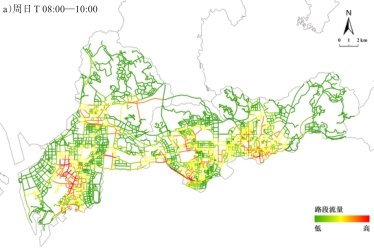 | 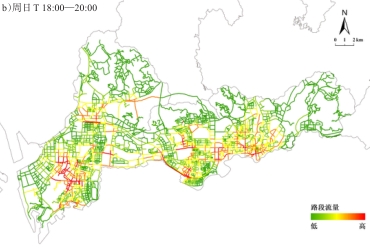 |
| 工 作 日 | 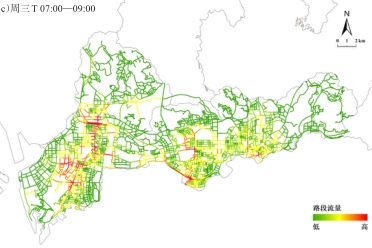 | 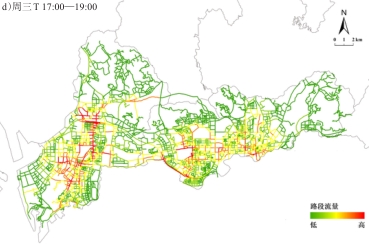 |
表2 建成环境空间自相关与多元线性逐步回归结果Table 2 Diagnostic results of spatial autocorrelation and multiple linear stepwise regression of built environment |
| 变量 | 空间自相关 | 多元线性逐步回归结果 | ||||||
|---|---|---|---|---|---|---|---|---|
| Moran's I | Z得分 | P值 | P值 | |||||
| 工作日早高峰 | 工作日晚高峰 | 休息日早高峰 | 休息日晚高峰 | |||||
| 人口密度 | 0.709 | 115.470 | 0 | 0.000** | 0.000** | 0.000** | 0.000** | |
| 居住设施密度 | 0.199 | 34.747 | 0 | 0.000** | 0.000** | 0.000** | 0.000** | |
| 就业设施密度 | 0.350 | 61.524 | 0 | 0.000** | 0.000** | 0.000** | 0.000** | |
| 餐饮设施密度 | 0.224 | 39.153 | 0 | ― | 0.029* | ― | ― | |
| 购物娱乐设施密度 | 0.301 | 52.902 | 0 | 0.000** | 0.000** | ― | 0.012* | |
| 功能混合度 | 0.198 | 34.317 | 0 | ― | ― | 0.006** | ― | |
| 天空开敞度 | 0.166 | 28.924 | 0 | 0.006** | 0.012* | 0.007** | 0.011* | |
| 街道绿视率 | 0.172 | 30.001 | 0 | 0.000** | 0.000** | 0.000** | 0.003** | |
| 建筑连续程度 | 0.095 | 16.636 | 0 | ― | 0.000** | ― | ― | |
| 围合度 | 0.238 | 41.598 | 0 | 0.000** | 0.000** | 0.000** | 0.000** | |
| 相对步行宽度 | 0.178 | 31.541 | 0 | 0.000** | 0.000** | 0.000** | 0.000** | |
| 交通安全设施占比 | 0.097 | 16.954 | 0 | 0.000** | 0.000** | 0.000** | 0.000** | |
| 接近度 | 0.641 | 111.526 | 0 | ― | ― | 0.002** | 0.000** | |
| 距地铁站最近距离 | 0.390 | 68.150 | 0 | 0.000** | 0.000** | 0.000** | 0.000** | |
| 距公交站最近距离 | 0.164 | 28.707 | 0 | 0.000** | 0.000** | 0.000** | 0.000** | |
|
表3 经典GWR和MGWR模型回归结果Table 3 Regression results of classical GWR and MGWR models |
| 模型指标 | 分时段模型结果 | |||
|---|---|---|---|---|
| 工作日早高峰 | 工作日晚高峰 | 休息日早高峰 | 休息日晚高峰 | |
| AICc(GWR) | 7 801.834 | 8 201.971 | 7 358.028 | 7 885.310 |
| AICc(MGWR) | 6 258.909 | 6 941.230 | 5 650.909 | 5 840.774 |
| 带宽(GWR) | 106 | 113 | 107 | 118 |
| 带宽(MGWR) | 30~4 692 | 30~4 692 | 30~4 676 | 30~4 692 |
| 调整R 2(GWR) | 0.778 | 0.768 | 0.806 | 0.794 |
| 调整R 2(MGWR) | 0.852 | 0.823 | 0.867 | 0.866 |
表4 MGWR模型回归结果统计Table 4 Statistics of MGWR model regression results |
| 变量 | 工作日早高峰 | 工作日晚高峰 | 休息日早高峰 | 休息日晚高峰 | |||||||||||
|---|---|---|---|---|---|---|---|---|---|---|---|---|---|---|---|
| 带宽 | 平均值 | 变量解释度 | 带宽 | 平均值 | 变量解释度 | 带宽 | 平均值 | 变量解释度 | 带宽 | 平均值 | 变量解释度 | ||||
| 调整R 2 | 0.852 | 0.823 | 0.867 | 0.866 | |||||||||||
| 人口密度 | 550 | 0.121 3 | 64.68 | 4 692 | 0.080 5 | 100 | 4 676 | 0.065 7 | 100 | 4 692 | 0.041 6 | 100 | |||
| 居住设施密度 | 266 | 0.013 5 | 11.27 | 166 | 0.002 8 | 5.43 | 472 | 0.006 6 | 13.54 | 479 | 0.009 5 | 11.91 | |||
| 就业设施密度 | 4 692 | 0.017 3 | 100 | 4 692 | 0.034 6 | 100 | 4 676 | 0.027 5 | 100 | 4 692 | 0.033 6 | 100 | |||
| 餐饮设施密度 | ― | ― | ― | 30 | 0.007 1 | 0 | ― | ― | ― | ― | ― | ― | |||
| 购物娱乐设施密度 | 1 291 | -0.043 9 | 24. 28 | 4 692 | -0.023 9 | 70.52 | ― | ― | ― | 1 291 | -0.038 4 | 17.03 | |||
| 功能混合度 | ― | ― | ― | ― | ― | ― | 72 | 0.019 1 | 6.74 | ― | ― | ― | |||
| 天空开敞度 | 30 | 0.060 5 | 5.71 | 30 | 0.055 6 | 5.43 | 30 | 0.039 3 | 6.78 | 31 | 0.051 4 | 6.07 | |||
| 街道绿视率 | 266 | 0.074 1 | 30.78 | 167 | 0.108 6 | 33.55 | 2 901 | 0.092 2 | 100 | 3 171 | 0.072 4 | 100 | |||
| 建筑连续程度 | ― | ― | ― | 1 230 | 0.079 4 | 81.29 | ― | ― | ― | ― | ― | ― | |||
| 围合度 | 4 692 | -0.188 1 | 100 | 4 692 | -0.265 1 | 100 | 4 676 | -0.213 5 | 100 | 4 692 | -0.212 7 | 100 | |||
| 相对步行宽度 | 30 | -0.082 3 | 5.20 | 909 | -0.100 7 | 79.07 | 1 805 | -0.057 3 | 79.75 | 31 | -0.060 8 | 5.22 | |||
| 交通安全设施占比 | 144 | 0.062 9 | 16.01 | 96 | 0.059 3 | 10.42 | 84 | 0.053 6 | 11.23 | 84 | 0.059 7 | 8.78 | |||
| 接近度 | ― | ― | ― | ― | ― | ― | 30 | -0.193 5 | 13.69 | 4 692 | -0.249 8 | 100 | |||
| 距地铁站最近距离 | 35 | -0.204 7 | 26.17 | 4 692 | -0.103 0 | 100 | 4 257 | -0.082 1 | 100 | 30 | -0.169 2 | 21.23 | |||
| 距公交站最近距离 | 2 911 | 0.006 7 | 1.39 | 2 071 | -0.006 7 | 13.92 | 2 901 | -0.018 5 | 0 | 871 | -0.052 8 | 28.11 | |||
|

1 www.openstreetmap.org
2 http://lbsyun.baidu.com
项振海、李青、盛杰:数据收集、处理,模型构建,论文撰写与修改;
洪 良:数据收集,整体构架和理论梳理;
班鹏飞:课题基金支持,论文讨论与修改。
|
Cervero Rodert and Kockelman Kara. 1997. Travel Demand and the 3Ds: Density, Diversity, and Design. Transportation Research Part D: Transport and Environment, 2(3): 199-219.
|
|
Cervero Robert. 2002. Built Environments and Mode Choice: Toward a Normative Framework. Transportation Research (Part D: Transport & Environment), 7(4): 265-284.
|
|
Chen Zheyan, Van Lieropdea, and Ettema Dick. 2020. Dockless Bike-Sharing Systems: What Are The Implications? Transport Reviews, 40(3): 333-353.
|
|
曹小曙,罗依. 2020. 中国大陆城市建成环境与共享单车配置的关系. 中山大学学报(自然科学版),59(1):77-85.
Cao Xiaoshu and Luo Yi. 2020. The Relationship between Urban Built Environment and Shared Bicycle Configuration in Chinese Mainland. Journal of Sun Yat-sen University(Natural Science Edition), 59(1): 77-85.
|
|
Fishman Elliot, Washington Simon, and Haworth Narelle. 2013. Bike Share: A Synthesis of the Literature. Transport Reviews, 33(2): 148-165.
|
|
Fotheringham Stewart, Yang Wenbai, and Wei Kang. 2017. Multiscale Geographically Weighted Regression (MGWR). Annals of the American Association of Geographers, 107(6): 1247-1265.
|
|
高枫,李少英,吴志峰,吕帝江,黄冠平,刘小平. 2019. 广州市主城区共享单车骑行目的地时空特征与影响因素. 地理研究,38(12):2859-2872.
Gao Feng, Li Shaoying, Wu Zhifeng, Lyu Dijiang, Huang Guanping, and Liu Xiaoping. 2019. Spatial-Temporal Characteristics and Influencing Factors of Shared Bicycle Cycling Destinations in the Main Urban Area of Guangzhou. Geographical Research, 38(12): 2859-2872.
|
|
Gao Feng, Li Shaoying, Tan Zhangzhi, Wu Zhifeng, Zhang Xiaoming, Huang Guanping, and Liu Xiaoping. 2021. Understanding the Modifiable Areal Unit Problem in Dockless Bike Sharing Usage and Exploring the Interactive Effects of Built Environment Factors. International Journal of Geographical Information Science, 35(9): 1905-1925.
|
|
Guo Yuanyuan, Yang Linchuan, and Chen Yang. 2022. Bike Share Usage and the Built Environment: A Review. Frontiers in Public Health, 10: 848169.
|
|
古维迎,范婉怡,陈义勇. 2022. 深圳城市街景绿化对共享单车使用的影响研究. 现代城市研究,(8):59-63.
Gu Weiying, Fan Wanyi, and Chen Yiyong. 2022. Study on the Impact of Urban Street Landscape Greening on the Use of Sharing Bikes in Shenzhen. Modern Urban Research, (8): 59-63.
|
|
郭源园,吴磊,曾鹏. 2023. 都市区建成环境对“共享单车+地铁”通勤使用影响的空间异质性——以深圳市为例. 热带地理,43(5):872-884.
Guo Yuanyuan, Wu Lei, and Zeng Peng. 2023. Spatial Heterogeneity of the Built Environment Effect on the Use of a Bike Share Metro Commute in a Metropolitan Area: A Case Study of Shenzhen. Tropical Geography, 43(5): 872-884.
|
|
黄沣爵,汤俊卿,林华丽,韩颂,赵鹏军. 2023. 基于多尺度地理加权回归模型的城市建成环境对共享单车空间分布影响研究. 地理研究,42(9):2405-2418.
Huang Fengjue, Tang Junqing, Lin Huali, Han Song, and Zhao Pengjun. 2023 Research on the Influence of Urban Built Environment on the Spatial Distribution of Shared Bicycles Based on Multi-Scale Geographically Weighted Regression Model. Geographical Research, 42(9): 2405-2418.
|
|
黄颙昊,杨新苗,岳锦涛. 2022. 基于多尺度地理加权回归模型的城市道路骑行流量分析. 清华大学学报(自然科学版),62(7):1132-1141.
Huang Yonghao, Yang Xinmiao, and Yue Jintao. 2022. Urban Street Bicycle Flow Analysis Based on Multi-Scale Geographically Weighted Regression Model. Journal of Tsinghua University(Science and Technology), 62(7): 1132-1141.
|
|
罗桑扎西,甄峰,尹秋怡. 2018. 城市公共自行车使用与建成环境的关系研究——以南京市桥北片区为例. 地理科学,38(3):332-341.
Luo Sang Tashi, Zhen Feng, and Yin Qiuyi. 2018. Research on the Relationship between Urban Public Bicycle Use and Built Environment: A Case Study of Qiaobei Area of Nanjing. Scientia Geographica, 38(3): 332-341.
|
|
Munshi Talat. 2016. Built Environment and Mode Choice Relationship for Commute Travel in the City of Rajkot, India. Transportation Research Part D: Transport and Environment, 44: 239-253.
|
|
莫海彤,魏宗财,翟青. 2019. 老城区共享单车出行特征及影响因素研究——以广州为例. 南方建筑,(1):7-12.
Mo Haitong, Wei Zongcai, and Zhai Qing. 2019. Travel Behaviors and Influencing Factors of Bike Sharing in Old Town: The Case of Guangzhou. South Architecture, (1): 7-12.
|
|
Meng Sian and Zacharias John. 2021. Street Morphology and Travel by Dockless Shared Bicycles in Beijing, China. International journal of Sustainable Transportation, 15(10): 788-798.
|
|
Rixey R Alexander 2013. Station-Level forecasting of Bikesharing Ridership: Station Network Effects in Three US Systems. Transportation Research Record: Journal of the Transportation Research Board, 2387(1): 46-55.
|
|
孙艺玲,仝德,曹超. 2018. 城市建成环境对公共自行车使用的影响机制研究——以深圳市南山区为例. 北京大学学报(自然科学版),54(6):1325-1331.
Sun Yilin, Tong De, and Cao Chao. 2018. How Urban Built Environment Affects the Use of Public Bicycles: A Case Study of Nanshan District of Shenzhen. Acta Scientiarum Naturalium Universitatis Pekinensis, 54(6): 1325-1331.
|
|
申犁帆,王烨,张纯,姜冬瑞,李赫. 2018. 轨道站点合理步行可达范围建成环境与轨道通勤的关系研究——以北京市44个轨道站点为例. 地理学报,73(12):2423-2439.
Shen Lifan, Wang Ye, Zhang Chun, Jiang Dongrui, and Li He. 2018. Research on the Relationship between Built Environment and Rail Commuting within Reasonable Walking Distance of Rail Stations: A Case Study of 44 Rail Stations in Beijing. Acta Geographica Sinica, 73(12): 2423-2439.
|
|
司睿,林姚宇,肖作鹏,叶宇. 2021. 基于街景数据的建成环境与街道活力时空分析——以深圳福田区为例. 地理科学,41(9):1536-1545.
Si Rui, Lin Yaoyu, Xiao Zuopeng, and Ye Yu. 2021. Spatial-Temporal Analysis of Built Environment and Street Vitality Based on Street Scene Data: A Case Study of Futian District, Shenzhen. Scientia Geographica, 41(9): 1536-1545.
|
|
邵海雁,靳诚,钟业喜,毛炜圣,杨艳. 2023. 共享单车起讫点与城市微观土地利用格局的空间关联——基于厦门岛的POI大数据. 经济地理,43(3):109-119,161.
Shao Haiyan, Jin Cheng, Zhong Yexi, Mao Weisheng, and Yang Yan. 2023. Spatial Correlation between the Origin and Destination of Bike-Sharing and Land Use Pattern in Xiamen Island Based on POI Data. Economic Geography, 43(3): 109-119, 161.
|
|
Tang Yang, Pan Haixiao, and Fei Yibo. 2017. Research on Users' Frequency of Ride in Shanghai Minhang Bike-Sharing System. Transportation Research Procedia, 25: 4983-4991.
|
|
王劲峰,徐成东. 2017. 地理探测器:原理与展望. 地理学报,72(1):116-134.
Wang Jinfeng and Xu Chengdong. 2017. Geodetector: Principle and Prospective. Acta Geographica Sinica, 72(1): 116-134.
|
|
王娜,吴健生,李胜,王宏亮,彭子凤. 2021. 基于多源数据的城市活力空间特征及建成环境对其影响机制研究——以深圳市为例. 热带地理,41(6):1280-1291.
Wang Na, Wu Jiansheng, Li Sheng, Wang Hongliang, and Peng Zifeng. 2021. Spatial Features of Urban Vitality and the Impact of Built Environment on Them Based on Multi-Source Data: A Case Study of Shenzhen. Tropical Geography, 41(6): 1280-1291.
|
|
王杰,范晓武,何逸昕,陶峰. 2022. 基于车牌自动识别数据的车辆OD轨迹还原. 计算机系统应用,31(7):247-252.
Wang Jie, Fan Xiaowu, He Yixin, and Tao Feng. 2022. Vehicle OD Trajectory Recovery Based on Automatic License Plate Recognition Data. Computer System Application, 31(7): 247-252.
|
|
严亚磊,于涛,沈丽珍. 2020. 共享单车出行的建成环境影响机制——以上海市为例. 上海城市规划,(6):85-91.
Yan Yalei, Yu Tao, and Shen Lizhen. 2020. The Impact Mechanism of Built Environment on Shared Bikes Travel: A Case Study of Shanghai. Shanghai Urban Planning Review, (6): 85-91.
|
|
杨林川,喻冰洁,梁源,赵桂林. 2023. 多源大数据支持下的共享单车出行与空间品质耦合研究. 西部人居环境学刊,38(4):47-54.
Yang Linchuan, Yu Bingjie, Liang Yuan, and Zhao Guilin. 2023. Research on Coupling of Shared Bicycle Travel and Spatial Quality Supported by Multi-Source Big Data. Western Journal of Human Settlements and Environment, 38(4): 47-54.
|
|
周艳,邵海雁,靳诚. 2023. 基于大数据的厦门岛建成环境对共享单车起讫点分布的影响. 南京师大学报(自然科学版),[2023-09-13]. [Zhou Yan, Shao Haiyan, and Jin Cheng. 2023. Influence of Built Environment of Xiamen Island on the Distribution of Starting Points of Shared Bicycles Based on Big Data. Journal of Nanjing Normal University(Natural Science Edition)[2023-09-13]. https://link.cnki.net/urlid/32.1239.N.20230912.1719.004.
|
/
| 〈 |
|
〉 |